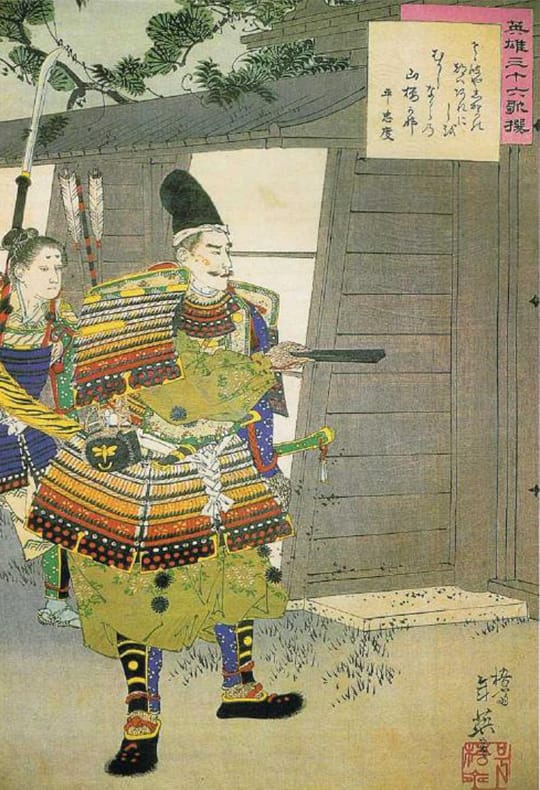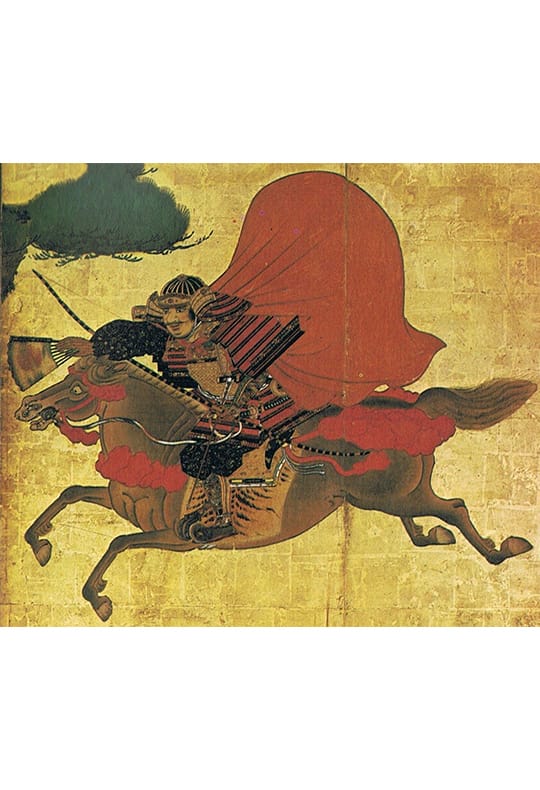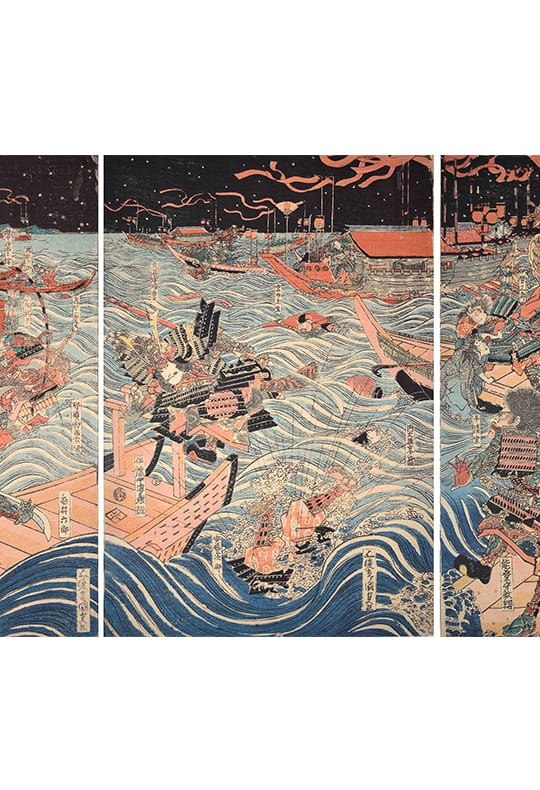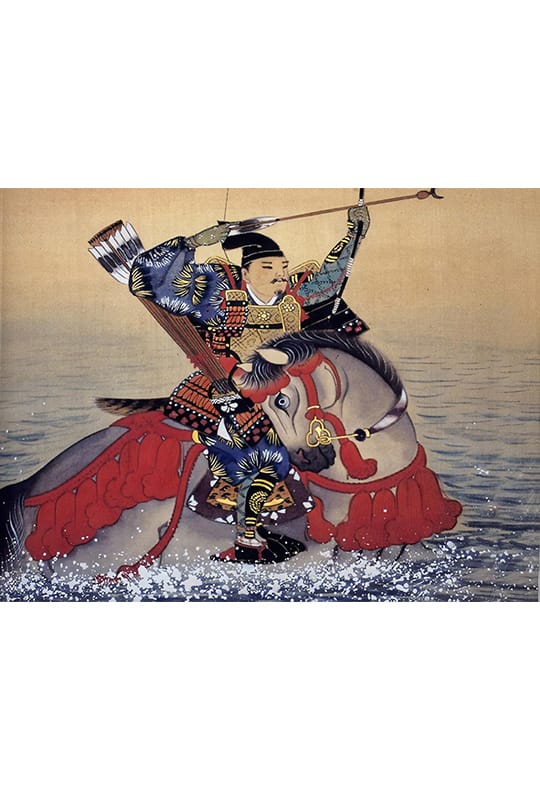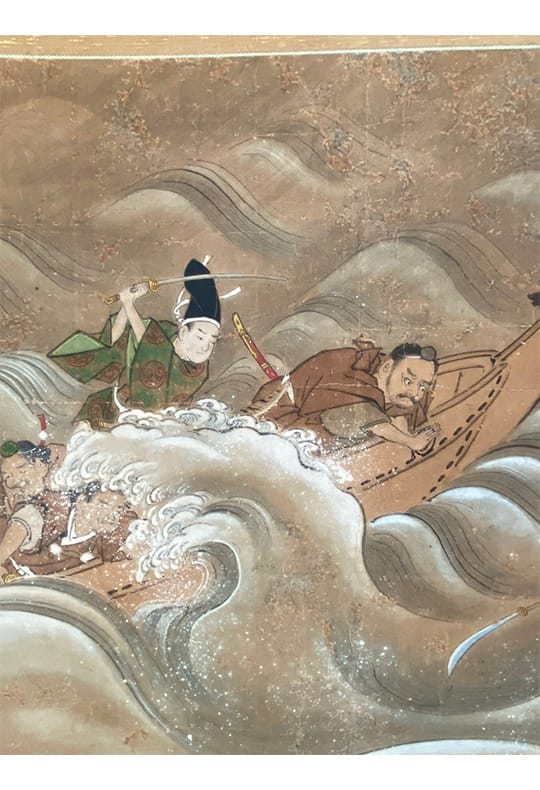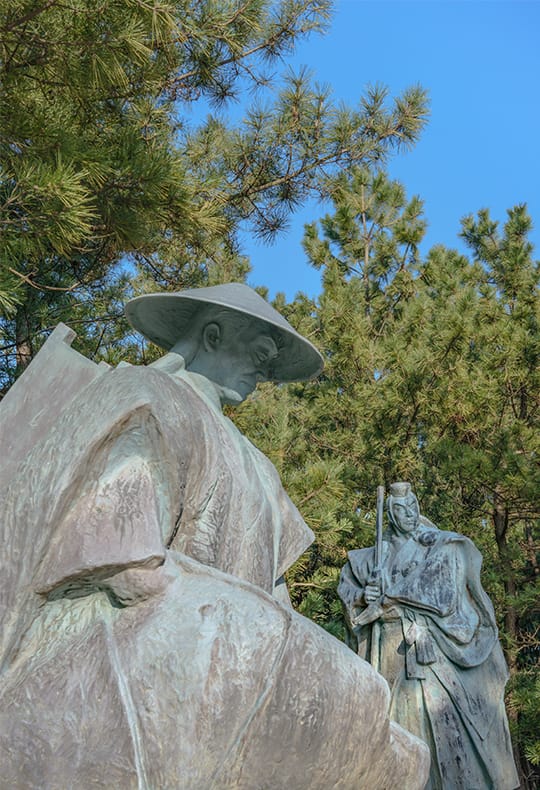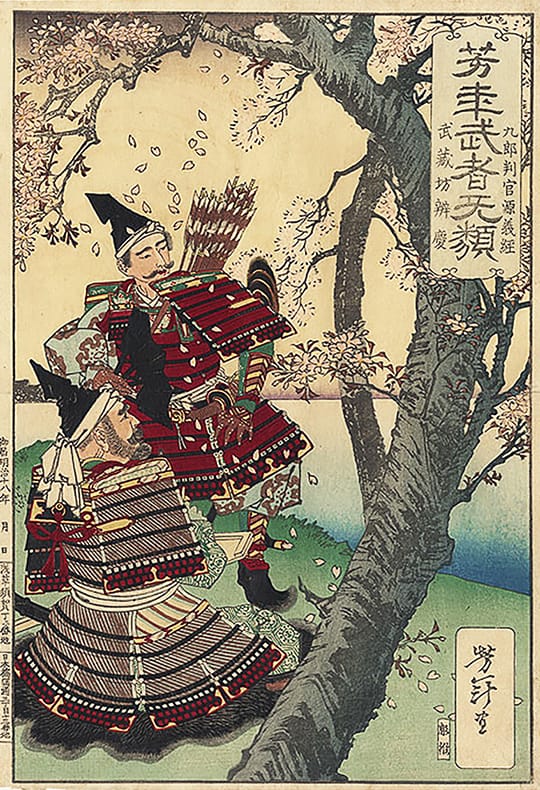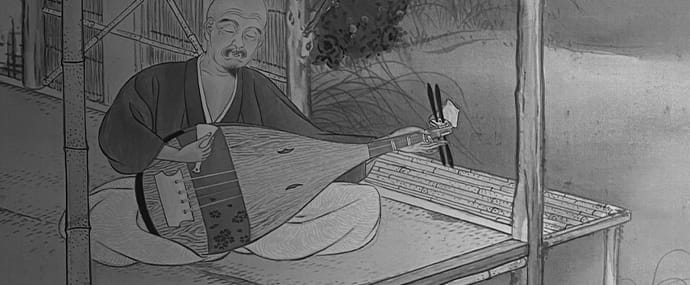The Tale of the Heike-search

dan no ura
壇ノ浦
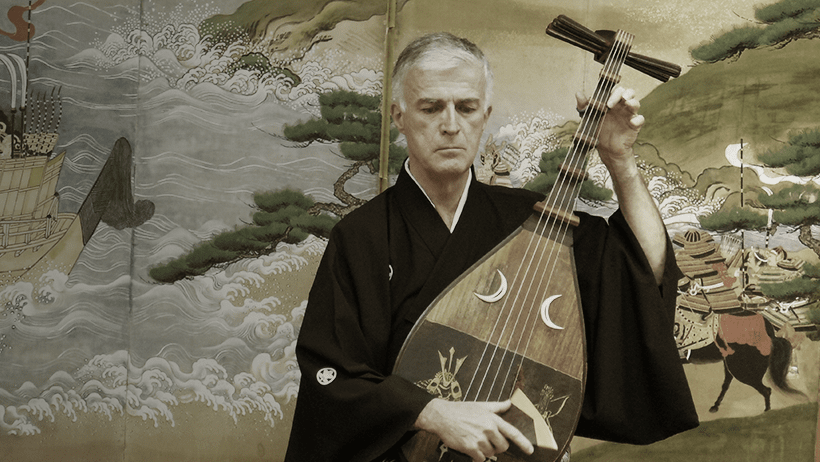
Introduction
The battle of Dannoura is perhaps the most significant military event in Japanese history. When the GENJI army defeated the HEIKE army, the Heian period (794-1185), a 400-year period of relative peace under imperial rule, ended. Two events marked the onset of the following Kamakura period (1185 -1333): the move of the central government to Kamakura, located close to present-day Tokyo, and the appointment of Yoshitsune’s elder half-brother, Yoritomo, as the first of many shogun to govern the country rather than the imperial court in Kyoto.
There are many versions of the Heike monogatari (The Tale of the Heike); however, the standard version for the heike biwa players was the Kakuichibon, a version reputedly created by Akashi Kakuichi (1299-1371), and handwritten copies of this. During the Edo period and later, other versions — several rufubon (lit. widely spread book), for example — were considered to be authentic. Since they were printed in the Edo-period, they were quite well known and more popular than the Kakuichibon.
The chikuzen biwa text is a condensed rendition of the Heike monogatari, a common occurrence with biwa ballads. Several colorful sections from the Heike monogatari are missing in the biwa piece, but one notable difference is the chronological change of the events. In the push for dramatic closure, the drowning of the emperor is placed at the end of the ballad, after Noritsune’s death rather than before. More startling is the recounting of child-emperor Antoku’s death. In most renditions of Dannoura, this episode is the most tragic; however, with the restructuring of the text, Nii no Tsubone, the Nun of the Second Rank, who jumped overboard while holding her grandchild, the child emperor in her arms, is conspicuously absent. Kenreimon’in, the mother of the emperor, is not referred to as such — she is only called by her rank of Nyoin — despite her pitiful portrayal in the Heike monogatari and Japanese literature of later periods.
Today, this piece is seldom performed in its entirety, the reason for which may be the weakness of the textual restructuring. In seeking a more convincing reading of this scene, YAMAZAKI Kyokusui, the artistic head of the Tachibanakai, later composed Dannoura Hikyoku, “The Tragedy of Dannoura”. In YAMAZAKI’s realization of the story, Antoku’s death is the narrative focus.
Synopsis
After a series of losses, the HEIKE army fled from the GENJI troops and moved their ships through the Inland Sea to the West. The final battle took place at Dannoura (Shimonoseki). The GENJI Commander-in-Chief, Yoshitsune, was determined to obliterate the severely outnumbered HEIKE army: the HEIKE had a mere 1000 vessels, which they divided into three groups, whereas the GENJI ships numbered 3000.
After a skirmish in which arrows were exchanged, the GENJI were able to penetrate the frontline of the HEIKE boats, at which point — in his hope against improbable odds — Tomomori, the HEIKE general, addressed his men and urged them to fight with what strength remained. The proximity of the boats was such that Yoshitsune proceeded from a GENJI vessel to a HEIKE one and encouraged his men to do the same. Noritsune, a peerless HEIKE warrior, saw this from afar and rushed to the boat Yoshitsune had just boarded with the burning desire of destroying the despised enemy with his own hands. Yoshitsune, aware of Noritsune’s strength and skill, evaded him with an incredible leap to another boat to then laugh at the inability of his would be destroyer to do the same. In his mortification, Noritsune seized two attacking GENJI warriors in a headlock and jumped overboard with them to vanish beneath the waves. With Noritsune’s death, Tomomori recognized the futility of their position and moved to the Imperial Boat with the suggestion that all members of the imperial party commit suicide. With this, Nii no Tsubone lifted the emperor Antoku, her grandchild, in her arms and threw herself and the child into the waves. When the emperor’s mother and other court women saw her remarkable display of bravery, they followed her example and threw themselves overboard. Yoshitsune, however, ordered the high-ranking HEIKE to be saved from drowning, but the young emperor had been swallowed by the waves.
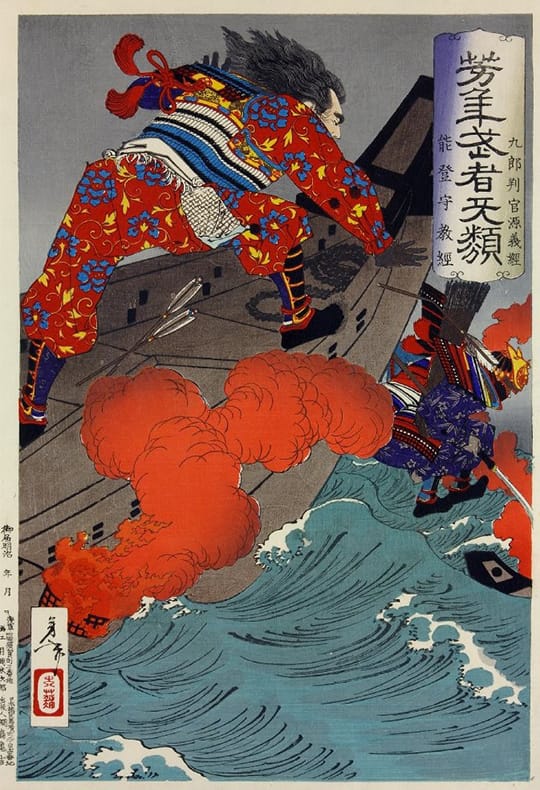
Lyrics
-
1. Having lost at Yashima, Nach der Niederlage in der Bucht von Yashima
Yashima sudeni ochiirite 屋島すでに陥落りて
-
2. The HEIKE retreated to Shidoura, zogen sich die HEIKE-Truppen nach Shidoura zurück.
HEIKE wa Shidoura ni shirizokishimo 平家は志度浦に退きしも
-
3. where yet again, they were attacked and routed by the GENJI. Dort wurden sie von GENJI-Kriegern wieder angegriffen,
mata mo GENJI ni oisemarare またも源氏に追ひ迫られ
-
4. They fled to the West, und so setzten sie die Flucht in Richtung Westen weiter fort.
nishi o sashite zo nogareshi ga 西を指してぞ遁れしが
-
5. drifting with the advancing waves, Der Strömung ohne Widerstand gehorchend
yoru kata nami no manimani 寄る方なみのまにまに
-
6. wandering along their final path, ließen sich die HEIKE auf dem letzten Pfade treiben –
sasurau HEIKE no matsuro koso さすらう平家の末路こそ
-
7. numbed with suffering and pain. Schmerz und Trauer lähmte sie unsäglich.
muzan to iu mo orokanare 無惨といふも愚なれ
-
8. The GENJI’s Great General, Yoshitsune, Yoshitsune, der große GENJI General,
koko ni GENJI no taishō Yoshitsune wa 茲に源氏の大将義経は
-
9. who had led his forces on both land and sea, der seine Truppen auf dem Wasser und zu Lande führte,
suiriku no taigun o hikii 水陸の大軍を率い
-
10. arrived at the island of Oizu in the Nagato domain. traf im Distrikt Nagato in Oizu ein.
Nagato no kuni Oizu ni kitari 長門の国奥津に来り
-
11. “This time the entire HEIKE clan „Ihr Männer, diesmal muss der ganze Clan der HEIKE
kono tabi koso wa HEIKE no ichizoku o 此度こそは平家の一族を
-
12. shall be destroyed to a man.” aufgerieben werden“,
ōsatsu sezunba yamumaji to 鏖殺せずんばやむまじと
-
13. he said, and soundly admonished his men. mahnte er mit lauter Stimme,
kibishiku mikata o imashimete きびしく味方をいましめて
-
14. The GENJI busily prepared for war, und so machten sich die GENJI-Krieger eilig für die Schlacht bereit.
ikusa no yōi ni isogawashi 合戦の準備に忙はし
-
15. and in the Second Year of Genryaku (1185), Es war im zweiten Jahr der Ära Genryaku (1185),
toki koso kitare Genryaku ninen 時こそ来れ元暦二年
-
16. on the Twenty-fourth Day of the Third Month at the Hour of the Hare, am 24. des dritten Monats in der „Hasen-Stunde“,
sangatsu nijūyokka no u no koku ni 三月二十四日の卯の刻に
-
17. the HEIKE and the GENJI fleets both set out, als die HEIKE und die GENJI
GENPEI ryōgun funade shite 源平両軍船出して
-
18. to face each other at Dannoura, dort bei Dannoura aufeinander trafen.
Dannoura nite ochiaishi ga 壇の浦にて落合ひしが
-
19. in the famed straits of Hayaseto. In der wohl bekannten Meeresenge von Hayaseto
koko wa nadakaki Hayaseto nite こゝは名高き速瀬戸にて
-
20. The HEIKE were rowing against the current ruderten die HEIKE gegen eine starke Strömung,
shikamo HEIKE wa shio ni sakarai 而も平家は潮流に逆ひ
-
21. whereas the GENJI were following it. die die GENJI umgekehrt zum Vorteil nutzten.
GENJI wa ushio ni shitagaeba 源氏は潮流に順へば
-
22. Under these conditions, Eine solche Ausgangslage
sono sama sanagara yosome ni wa 其の状宛然よそめには
-
23. it was regrettably clear that the oft defeated HEIKE army machte deutlich, dass die oft geschlagnen HEIKE,
sude ni HEIKE no makeikusa to すでに平家の敗軍と
-
24. would again meet with ill fate, auch diesmal keinen Sieg erhoffen konnten,
miyuru bakari zo fuun naru 見ゆるばかりぞ不運なる
-
25. in spite of their experienced fleet. trotz Erfahrenheit zur See.
sabare funaikusa ni kotonareshi さばれ船合戦に熟練し
-
26. Nevertheless, the HEIKE generals felt no fear, Dennoch zeigten alle HEIKE-Generale keine Furcht.
HEIKE no shōsotsu sukoshimo sawagazu 平家の将卒少しも騒がず
-
27. and divided their thousand ships into three groups; Sie teilten ihre Schiffe in drei Gruppen auf,
issen yosō o sandan ni wakachi 一千余艘を三段に分ち
-
28. to the cries of “eiya eiya,” the rowers synchronized their strokes, „Eya, eya“ riefen sie und ruderten im Gleich-Takt
eiya eiya no robyōshi soroe エイヤエイヤの櫓拍子揃へ
-
29. and rapidly approached. schnell hinüber zu den den Feinden.
ikioi surudoku kogiyosuru 勢ひ鋭く漕ぎ寄する
-
30. The GENJI ally from Kii province, Der Verbündete der GENJI aus dem Lande Kii,
GENJI ni arite wa Kii no kuni no jūnin 源氏にありては紀井の国の住人
-
31. KUMANO no Tanzō, led the GENJI vanguard. KUMANO no Tanzō, übernahm die Führung,
KUMANO no Tanzō o senjin to shi 熊野の湛増を先陣とし
-
32. Raising his flag with its image of the god, Kongō Dōji, hisste seine Flagge mit dem Bild des Gottes Kongō Dōji –
Kongō Dōji no hata oshitate 金剛童子の旗押し立て
-
33. he advanced with great dignity. avancierte würdevoll.
ifū dōdō tosshinsu 威風堂々突進す
-
34. Next was KŌNO Michinobu from the province of Iyo, Der nächste war KŌNO Michinobu vom Lande Iyo,
tsuzuite Iyo no kuni no jūnin KŌNO Michinobu 続いて伊予の国の住人河野通信
-
35. who led the warriors from the shores of Shikoku. der die Truppen von den Küstenstreifen in Shikoku führte.
Shikoku no AMABE o hikii 四国の海部を率い
-
36. With other boats, they numbered 3000 vessels. Insgesamt 3000 Schiffe zählte ihre Flotte im Verband,
kono hoka hyōsen sanzen yosō 此の外兵船三千余艘
-
37. and surrounded the HEIKE ships, Sie kreiste nun die HEIKE Boote ein,
HEIKE no gun o kakoman to 平家の軍を囲まんと
-
38. each rushing forward as they vied with the other to arrive first. wobei ein jedes Schiff ein anderes zu überholen trachtete.
aseri kisoite susumiyuku あせり競ひて進み行く
-
39. That moment when both armies were within bow range, Als beide Flotten sich in Schussdistanz genähert hatten,
ryōgun yagoro ni chikazukeba 両軍矢頃に近づけば
-
40. they suddenly took up arms. griff man zu den Waffen.
sentan tachimachi koko ni hirake 戦端忽ち爰に開け
-
41. Battle cries raised, Es erhob sich ein Geschrei,
ichido ni aguru toki no koe 一度に揚ぐる鯨波の声
-
42. together with the noise of crashing breakers das – mit dem Wellen-Rauschen sich verbindend –
iso utsu nami no oto morotomo 磯打つ波の音もろとも
-
43. resounded balefully in the mountains. von den Bergen widerhallte.
yama ni hibikite monosugoshi 山に響きて物凄し
-
44. For hours they fought, shooting at each other, Manche Stunde wurde hart gekämpft,
shibashi ga hodo wa yaikusa nite しばしが程は矢合戦にて
-
45. each side desperate to gain the upper hand. verzweifelt ringend um den Vorteil in der Schlacht.
tagai ni shōhai aritsuru mo 互に勝敗ありつるも
-
46. The GENJI fleet, pushed by the rapid current, sped like arrows, Die GENJI-Flotte war begünstigt durch die Strömung,
iru ya no gotoki hayashio ni 射る矢の如き速潮に
-
47. advanced quickly with their fighting ships. und so preschten ihre schnellen Boote vor wie Pfeile,
osarete susumu GENJI no gunsen 押されて進む源氏の軍船
-
48. Breaking through the ranks of the enemy’s front, brachen in die Feindes-Ränge vor.
matataku hima ni tekigun no またゝくひまに敵軍の
-
49. they penetrated deep into the heart of their fleet, bedrängten immer mehr die HEIKE-Flotte,
mattadanaka o tsukiyabureba 真只中を突き破れば
-
50. and drew next to the HEIKE boats. bis sie an die gegnerischen Boote stießen.
fune to fune to wa sesshokushi 船と船とは接触し
-
51. Enemy and ally were indistinguishable. Damit waren Freund und Feind nicht mehr getrennt.
teki mo mikata mo irimidare 敵も味方も入り乱れ
-
52. The broad straits of Hayatomo Seto Die breite Meeresstraße von Hayatomo Seto
sashimo ni hiroki Hayatomo no さしもに闊き早鞆の
-
53. were blanketed with ships, war von Schiffen übersät,
Seto mo fune nite ōwarete 瀬戸も船にて覆はれて
-
54. like fallen leaves floating on river eddies, als wären es gefallene Blätter, die in einem Flusse strudeln
ochiba ukaburu kawanami no 落葉浮ぶる川波の
-
55. collected in wickerwork nets. und von Flechtwerkkörben aufgefangen werden.
ajiro ni yosuru gotoku nari 網代に寄する如くなり
-
56. At this time, the Shinchūnagon Tomomori, Shinchūnagon Tomomori, der HEIKE-General
kakarikeru toki Shinchūnagon Tomomori wa かゝりける時新中納言知盛は
-
57. appeared and stood at the prow of his ship. bewegte sich zum Bug vor seine Leute hin und sprach:
fune no miyoshi ni tsuttachite 船の船首に突っ立ちて
-
58. “My friends, my allies! Listen! „Ihr Freunde, Alliierte, hört!
mikata no monodomo uketamaware 味方の兵共も承れ
-
59. The fate of our clan is at stake in this battle. Jetzt geht es um das Schicksal unsrer Sippe.
ichimon no unmei kono issen ni ari 一門の運命この一戦にあり
-
60. Work as one! Combine your strengths! Rafft euch auf und bündelt eure Kräfte,
kokoro o awase chikara o awase 心を協せ力を合せ
-
61. Crush the enemy at any cost!” schwört mir, dass ihr unsern Feind zerstört!“
chikatte teki o uchiyabure to 誓って敵を撃破れと
-
62. he shouted twice, and then once again. Dies rief er zweimal – dreimal.
futatabi mitabi yobawattari 二度三度呼はったり
-
63. The HEIKE warriors all heard, Als die HEIKE dies vernahmen,
HEIKE no shōshira kore o kiki 平家の将士等之を聞き
-
64. and with this their spirits rose. kamen sie in Kampfes-Stimmung.
isamitachitaru orishimo are 勇み立ちたる折しもあれ
-
65. From between the islands Kanju and Manju Zwischen Manju hier und Kanju dort, den beiden Inseln,
Manju Kanju no shimaai yori 満珠干珠の島間より
-
66. the drums of the advancing army rumbled dröhnten nun die GENJI-Kriegestrommeln
shingun no taiko tōtō to 進軍の太鼓鼕々と
-
67. like thunder in the area of the GENJI troops. hin zum feindlichen Bereich der HEIKE-Truppen.
GENJI no kata ni nariwatari 源氏の方に鳴り渡り
-
68. Their crest, a black gentian with bamboo leaves on white, Das Enzianemblem – schwarz auf weiß –
shiroji ni kuro no sasarindō 白地に黒の笹龍胆
-
69. marked the flags lining their ships, es zierte alle Flaggen auf den GENJI-Schiffen,
uttaru hata o tatetsurane 打ったる旗を立て連ね
-
70. as they rowed forth with all their strength. die voll Kraft herangerudert wurden.
ikioikonde kogiidasu 勢ひ込んで漕ぎ出だす
-
71. In one group, In der einen Gruppe,
kono ichidan zo Yoshitsune no 此の一団ぞ義経の
-
72. was the boat of a close retainer, war ein eng verbündeter Vasall,
hatamoto nari to shirarekeru 麾下なりと知られける
-
73. from which Yoshitsune leapt to an enemy’s boat, von dessen Schiff Yoshitsune im Sprung ein HEIKE-Boot erreichte.
yagate Yoshitsune tekijin ni norichikazuke やがて義経敵陣に乗近づけ
-
74. where he encouraged his men So etwas macht Mut,
mikata o hagemashi jūōmujin 味方を励まし縦横無尽
-
75. to sweep away everything in their path, to fight without reservation. die Genji kämpften ohne Rückhalt, fegten alles aus dem Weg.
nagitsu haraitsu funsensu 薙ぎつ払ひつ奮戦す
-
76. With the wondrous speed of a demon, Wie Teufel rasend
kijin fushigi no hayawaza ni 鬼神不思議の早業に
-
77. he crushed the entire HEIKE army schlugen sie das HEIKE-Heer,
HEIKE no zengun oshikuzusare 平家の全軍押崩され
-
78. destroying any hope of recovery. dass diesen armen Kriegern alle Hoffnung schwand.
mata morikaesu iro mo nashi また盛り返す色もなし
-
79. Noritsune, the Lord of Noto, Der HEIKE Fürst von Noto, Noritsune,
Notonokami Noritsune wa 能登ノ守教経は
-
80. saw this from afar. sah dies aus der Ferne.
koko no arisama o haruka ni mite 此の有様を遥に見て
-
81. “Indeed, this is Yoshitsune, „Wahrlich, das ist Yoshitsune,
are koso Kurō ni magirenashi あれこそ九郎に紛れなし
-
82. Let’s fight with him!” he said, lasst mich mit ihm kämpfen!“ rief er laut
ide hikkunde uchitoran to いで引っ組んで討ち取らんと
-
83. and he worked his way through the ally ships und überquerte alle Schiffe,
mikata no fune o oshiwake oshiwake 味方の船を押分け押分け
-
84. until he reached Yoshitsune’s boat. bis er Yoshitsunes Boot erreichte.
Yoshitsune no fune ni chikazuki yori 義経の船に近づき寄り
-
85. “You! You must be the GENJI general, „Ha, du musst der General der GENJI sein,
yaa sore naru wa GENJI no ヤアそれなるは源氏の
-
86. the Great Yoshitsune! der große Yoshitsune!
taishō Yoshitsune naru ka 大将義経なるか
-
87. I am the second son of the Kadowaki Chūnagon Norimori, Ich, der zweite Sohn des Chūnagon Norimori
ware wa Kadowaki Chūnagon Norimori no jinan 我は門脇中納言教盛の二男
-
88. Noritsune, the Lord of Noto!” bin Noritsune, der Fürst von Noto.“
Notonokami Noritsune nari to 能登ノ守教経なりと
-
89. With these words, he hurled his helmet aside, Mit diesen Worten schmiss er seinen Helm zur Seite,
iu yori hayaku kabuto o nugisute 云ふより早く甲を脱ぎ捨て
-
90. ripped off the sleeves of his armor, riss die Ärmel seiner Rüstung ab
yoroi no sode o hikichigiri 鎧の袖を引き断り
-
91. and jumped onto Yoshitsune’s ship. und sprang hinüber auf das Boot von Yoshitsune.
Yoshitsune no fune ni odoriiru 義経の船に躍り入る
-
92. The GENJI warriors were amazed, Die GENJI Krieger hatten einen Schock,
GENJI no bushidomo odoroki awate 源氏の武士共驚きあはて
-
93. but threw themselves on Noritsune, doch warfen sie sich flugs auf Noritsune
Noritsune ni kumi sugaru o 教経に組み縋るを
-
94. who kicked and dodged with a lion’s fury. um mit Hieben und mit Schlägen wild wie Löwen ihn zu übermannen.
ketaoshi nagenoke shishifunjin 蹴倒し投除け獅子奮迅
-
95. In an instant, Noritsune had closed on his prey, Noritsune war trotz allem plötzlich seinem Ziele nah.
awaya Yoshitsune ni oisemaru あわや義経に追ひ迫る
-
96. but Yoshitsune had always been fleet of foot, and like a bird, Da schnellte Yoshitsune, als wäre er ein Vogel,
motoyori Yoshitsune kyōshō hichō no gotoshi 固より義経蹻捷飛鳥の如し
-
97. immediately threw himself in the air, unversehens in die Luft
tachimachi hirari to mi o odorashi 忽ちヒラリと身を跳らし
-
98. to soar a good six meters, und landete sechs Meter weit entfernt
nijō amari mo hedatetsuru 二丈あまりも隔てつる
-
99. and lightly land on an ally ship, auf einem Schiff der eignen Leute,
mikata no fune ni tobiutsuri 味方の船に飛び移り
-
100. where he remained, a light smile hovering on his lips, wo er lächelnd stehen blieb.
nikko to waratte owashishi wa 莞爾と笑って在しゝは
-
101. a feat no different from that of a tengu-demon. Das war die Leistung eines tengu-Teufelskerls!
Tengu no waza ni mo kotonarazu 天狗の業にも異らず
-
102. The unmatched warrior, Noritsune, Der große Krieger Noritsune
gōyū musō no Noritsune mo 剛勇無双の教経も
-
103. tried to follow him, but lacking such wings, wollt‘ ihm folgen, hatte aber keine solchen Schwingen
owan to suru ni tsubasa naku 追はんとするに翼なく
-
104. “Aa, he flies! He truly flies!” „Ach der fliegt – der fliegt ja wirklich!“
aa tobitari na tobitari na to あゝ飛びたりな飛びたりなと
-
105. he sighed in spite of himself. seufzte er verzweifelt.
omowazu shirazu kantan seri 思はず知らず感嘆せり
-
106. Then, two bold GENJI warriors, Nun gelang es zweien von den GENJI-Leuten,
kakaru tokoro ni GENJI no yūshi 斯る処に源氏の勇士
-
107. AKI no Tarō and his brother Jirō, AKI no Tarō und seinem Bruder Jirō,
AKI no Tarō onajiku Jirō 安芸の太郎同じく次郎
-
108. attacked Noritsune from the left and the right. Noritsune von links und rechts zu attackieren.
Noritsune no migi hidari yori kumitsukeba 教経の右左より組付けば
-
109. “Ei! The two of you shall accompany me to the Realm of the Dead!” „Ah, ihr zwei kommt mit ins Totenreich“ rief er
ei nanjira shide no tomo seyo to エイ汝等死出の供せよと
-
110. and he seized both, one under each arm, und quetschte beide unter seine Arme,
yaniwani futari o ryōwaki ni hikihasami やにわに二人を両腋に引挟み
-
111. and plunged into the roiling waves, stürzte sich mit ihnen in die Flut
sakamaku nami ni tobiirite 逆巻く浪に飛入りて
-
112. never to be seen again. und war nie mehr gesehen.
sugata wa miezu narinikeri 姿は見えずなりにけり
-
113. When Tomomori heard Als Tomomori hörte,
saruhodo ni Tomomori wa さるほどに知盛は
-
114. of Noritsune’s death, dass Noritsune den Tod erlitten hatte,
Notonokami no senshi o kiki 能登ノ守の戦死を聞き
-
115. he knew their struggle had come to an early end, war für ihn der Krieg verloren.
ikusa mo mohaya kore made nari to 合戦も最早之迄なりと
-
116. and rushed to the Imperial Boat, Schnell ging er zum Kaiser-Boot
isogi mifune ni kogiitari 急ぎ御船に漕ぎ到り
-
117. where he faced the court ladies. und sprach zu jenen edlen Damen dort:
nyōbōtachi ni uchimukai 女房達に打向ひ
-
118. “It seems you will now meet the Brutes of the East. „Ihr werdet bald die Ostbarbaren zu Gesicht bekommen,
tada ima azumaotoko o goranzubekere 只今東男を御覧ずべけれ
-
119. Anything offensive to the eye werft jetzt weg, was diese Brut an Euch erinnern könnte,
mazu migurushiki monodomo wa まづ見苦しき物共は
-
120. must be thrown into the sea.” in die See.“
umi ni nageiremesare sōrae to 海に投入れめされ候へと
-
121. He himself took a broom Er selber nahm den Besen,
onore mizukara hōki o tori おのれ自ら箒を把り
-
122. and swept the ship clean before he took his leave. reinigte das Kaiserliche Schiff,
haki kiyomete zo kaerareshi ga 掃き清めてぞ帰られしが
-
123. In the end, he too vanished beneath the waves. bevor er sich das Leben nahm und in der Meeresflut verschwand.
tsuini umi ni shizumite usenikeri 遂に海に沈みて亡せにけり
-
124. When the Imperial Lady Kenreimon’in heard this, Als Kenreimon’in dies erfuhr,
nyoin wa kaku to kikoshimesare 女院はかくと聞し召され
-
125. she remained calm without a tremor. da blieb sie ruhig und gefasst.
sawagase tamō mikeshiki naku 騒がせ給ふ御気色なく
-
126. She took a warming-stone and an ink stone, Sie nahm den Wärme- und den Tuschestein,
on‘yakiishi to misuzuri to o 御焼石とみすゞりとを
-
127. and placing them in the depths of her sleeves, um ihre Ärmel zu beschweren,
sō no tamoto ni iretamai 左右の袂に入れ給ひ
-
128. faced the West with her hands pressed together, wandte sich gen Westen, faltete die Hände zum Gebet
nishi ni mukaite gasshō shi 西方に向ひて合掌し
-
129. to pray in silence. und gab sich stiller Einkehr hin.
shizuka ni mokutō arasetamō 静に黙祷あらせ給ふ
-
130. The wife of the Major Counselor Tokitada Die Frau des Dainagon Tokitada
kono toki Dainagon Tokitada no fujin 此時大納言時忠の夫人
-
131. then moved to her side. rückte dann an ihre Seite:
onsoba chikō haberishi ga 御側近う侍りしが
-
132. “Let me be your guide.” she said, „Lasst mich Eure Hoheit führen“,
iza onmichishirube sōrōbeshi to いざ御道しるべ候べしと
-
133. and threw herself into the waves. sagte sie und sprang als erste in die Fluten.
zanbu to kaichū ni tobiireba ザンブと海中に飛入れば
-
134. What a heart-rending moment this was! Ist das nicht erschütternd!
anaya to iu ma mo itamashiya あなやといふ間も痛ましや
-
135. And was soon followed by the other court ladies, Kenreimon’in trat nun auch ins Wellen-Reich
nyoin mo umi ni irasetamaeri 女院も海に入らせ給へり
-
136. And soon followed by the other court ladies, gefolgt von andern Damen ihres Hofes,
okure tatematsuraji to kyūjora mo おくれ奉らじと宮女等も
-
137. who held hands as they leapt into the sea. die beim Sprung ins Wasser ängstlich sich die Hände hielten.
te o toriaitsu umi ni iru 手を取り合ひつ海に入る
-
138. But at that moment, ISE no Saburō Yoshimori Plötzlich näherte sich ISE no Saburō Yoshimori
orishimo ISE no Saburō Yoshimori 折しも伊勢の三郎義盛
-
139. rapidly approached in a light boat. in einem flinken Boot.
hayabune nite hasekitari 快舟にて走せ来り
-
140. “The court ladies are throwing themselves into the waves! „Die Hohen Damen stürzen sich ins Wasser,
umi ni wa tōtoki katagata no irasetamōzo 海には尊き方々の入らせ給ふぞ
-
141. Kindly have them saved!” rettet sie, zeigt Mitleid!“
nengoro ni sukui tatematsureya to 懇ろに救ひ奉れやと
-
142. he communicated Yoshitsune’s order. rief er auf Yoshitsunes Geheiß.
Yoshitsune no mei o tsutōreba 義経の命を伝ふれば
-
143. The Imperial Lady was saved, as were Man konnte Kenreimon’in retten
nyoin o hajime tatematsuri 女院をはじめ奉り
-
144. Suke no Tenji and the other ladies, sowie Suke no Tenji und auch andere Damen.
Sukenotenji sono ta no nyokanra 帥の典侍其他の女官等
-
145. and the tragic Munemori and his son Selbst den armen Munemori konnte man mit seinem Sohn
aware Munemori oyako made あはれ宗盛父子まで
-
146. were saved from the waves here and there, noch aus den Fluten ziehen
koko kashiko yori sukuwarete 此処彼処より救はれて
-
147. and brought before the GENJI troops. und den GENJI übergeben.
GENJI no kata e okurareshi mo 源氏の方へ送られしも
-
148. Of the Former Emperor, there was no trace, Doch vom ehedem erwählten Kaiser fehlte jede Spur;
sentei no onkage nomi wa 先帝のおん影のみは
-
149. as he had vanished, hidden in the clouds and mists. er hatte sich ins Wolkenreich begeben –
izuko no kumo ni ya kakuretamaiken いづこの雲にや隠れ給ひけん
-
150. Nobody was to see him again. niemand hat ihn jemals mehr gesehen.
ogamishi mono zo nakarikeru 拝みし者ぞなかりける
-
151. Those whose fate was to get away could get away; Wem bestimmt war zu entkommen, konnte fliehen,
otsubeki mono wa mina ochinu 落つべきものは皆落ちぬ
-
152. those whose fate was to die, died. wem bestimmt war, nun zu sterben, starb.
shisubeki mono wa mina shishinu 死すべき者は皆死しぬ
-
153. Those whose fate was to survive, survived; In Hikishimas Fluten, in der Odo-Meeresstraße
shio no Hikishima Odo no Seto 汐の引島小戸の瀬戸
-
154. the desolate sight of abandoned ships trieben Schiffe steuerlos umher,
nushi naki fune no sabishige ni 主なき船の淋しげに
-
155. floating aimlessly without their pilots; vereinsamt hierhin – dorthin, ohne Ziel.
yurare yurarete inishi ato ゆられゆられて去にしあと
-
156. The white flags flourished like foam, Die weißen Flaggen auf dem weißen Schaum der Wellen tanzend
shiranami narade shirahata no しら波ならで白旗の
-
157. marking a new era of prosperity, kündeten vom Aufbruch in die neue Zeit,
tokimeku yo to wa narinikeri 時めく世とはなりにけり
-
158. marking a new era of prosperity. kündeten vom Aufbruch in die neue Zeit.
tokimeku yo to wa narinikeri 時めく世とはなりにけり
Notes
1.Yashima… located in Sanuki Domain or present-day Kagawa Prefecture. One month before the battle of Dannoura (1185), the GENJI army of MINAMOTO no Yoshitsune attacked and conquered the HEIKE army in Yashima. 2. Shidoura…located in Sanuki Domain east of Yashima (present-day Sanuki City in Kagawa Prefecture). 10. Oizu in Nagato… (also Oitsu) Another name for the island of Manjushima in the western part of Yamaguchi Prefecture 15./16. detailed date refers to: 6 o’clock in the morning of the solar calendar April 25th, 1185. 18. Dannoura…Present-day Dannourachō in the city of Shimonoseki, Yamaguchi Prefecture. 19. Hayaseto… A strait between Moji and Dannoura where the tide is especially strong (also called Hayatomo no Seto). 20./ 21. This notion is the opposite of what is told in the Rufubon (popular version) in which it is the HEIKE who are using the current, and the GENJI are laboring against it. 31/32. Kumano no Tanzō… He was a priest of a shrine in Wakayama Prefecture. Shortly before the battle of Dannoura he joined the GENJI side. The deity of his Shrine is Kongō Dōji, which has a fearful outlook and wields a mallet in pictorial representations. 34. KŌNO Michinobu… He was a member of an important clan in Iyo no Kuni (Ehime prefecture). He switched to the GENJI side at an early stage and had already fought with TAIRA no Noritsune. 55. wickerwork nets… This is a type of a fishing net crafted from bamboo slivers and placed in rivers to catch fish. 56. Shinchūnagon Tomomori… The “New Middle Counselor of the HEIKE” was Tomomori, the son of Kiyomori, the HEIKE clan-head, and younger brother of the main general Munemori. 65. Manju Kanju… This indicates is Manjushima and Kanjushima, two islands in the strait of Shimonoseki, where the GENJI troops positioned themselves. 68. Black gentian…The gentian (sasarindō lit. “gentian with bamboo leaves”) was the family crest of the Seiwa GENJI, the GENJI family-line to which Yoshitsune belonged. 79. Noritsune… He was the son of the HEIKE clan head Kiyomori’s younger brother Norimori. In The Tale of Heike he is depicted as a valiant warrior, but there is also a theory that he had already been beaten in the battle of Ichinotani. 87. Kadowaki Chūnagon Norimori… Kadowaki Middle Counselor Norimori was the younger brother of TAIRA no Kiyomori; he drowned in the final battle of Dannoura. 98. The length is given as nijō which is about 6 metres. 101. Tengu… A tengu, a forest goblin, is said to have instructed Yoshitsune in the martial arts, when he was a youngster in the woods in Kurama to the north of Kyoto. Tengu supposedly have wings and can fly. They also have large protruding noses and terrifying eyes. 107. AKI no Tarō and Jirō… According to the Rufubon (s. notes of line 20./21.), these two brothers are from Tosa (Kōchi prefecture) 118. Brutes of the East … They were called Azuma otoko – a term for the GENJI warriors, lit. “the Eastern guys”. For the HEIKE warriors in the Heike Monogatari, this was an expression of nervous laughter combined with disdain. 124. Kenreimon’in…in the ballad, she is only referred to by her rank, nyoin. Her name was Kenreimon’in Tokuko. She was Kiyomori’s daughter, and the mother of emperor Antoku. 128. Faced the West… This means “faced to the direction of the paradise”, which was believed to lie in the West. 130. The wife of Major Counselor Tokitada… Tokitada was the brother of Tokiko who was Kiyomori’s wife. Tokitada’s wife Sochinosuke was the wet nurse of emperor Antoku. 138. ISE no Saburō Yoshimori… A retainer of Yoshitsune. 144. Sukenotenji…Also called Sochinosuke, she was the wife of TAIRA no Tokitada (see note 130) 145. Munemori and his son… The great general TAIRA no Munemori was forced to jump into the sea together with his son Kiyomune. Both were said to be good swimmers and they were thus rescued before drowning. 148. The Former Emperor… Emperor Antoku, the youngest emperor in Japanese history. He ascended the throne at the age of two and died at the age of eight. Here, he is referred to as the “former emperor”, because his younger, four year-old brother, Gotoba Tennō, had been enthroned in the capital, but without the “Three Treasures” after emperor Antoku had been taken by the HEIKE. The defeat of the HEIKE seemed certain even before the conclusions of this final battle. 149. hidden in the clouds and mist… The original wording for the emperor’s death is: “he disguised himself behind the clouds”, which is an elegant way of noting the death of a member of the aristocracy. 156. White flags… were the banners of the GENJI. The HEIKE flags were red.
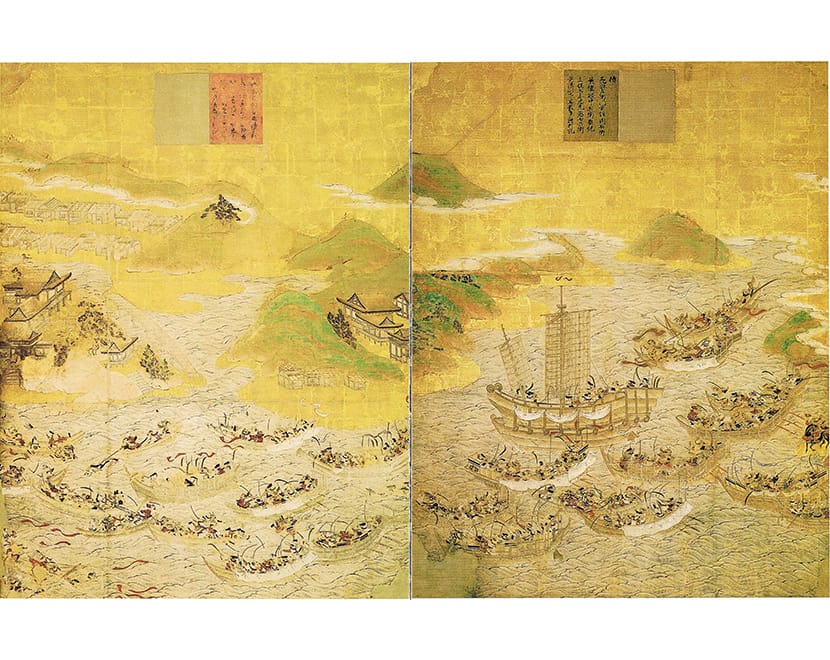
Music Notes
Dannoura is approximately 30 lines longer than an average piece from the chikuzen biwa repertoire. As the most important story from the Tale of the Heike, the musical structure of the ballad reflects, as may be expected, some peculiarities.
The opening, for example, is highly unusual in that the expected general introduction (makura), in which the narrator broods over human fate, is missing. It begins, instead, with a sober report of the military situation at the outset of the forthcoming battle. The factual directness of the first lines means that the voice does not dive into the lower registers as would normally be expected. Only the first two words of line 5, yoru kata, start on the pitch otsu, which is one fourth below the basic tone “three”. All other singing is set on “three” or above, “four”, and even briefly, “five” and “six”.

Another rather unusual music setting soon follows in line 18, when for the first time the word “Dannoura” appears, and is set to a nagashi: the traditional arioso-pattern used to highlight the text, which stretches over three lines. From the viewpoint of the musical setting, this makes sense, but it is nonetheless surprising that after a short interlude, another full-length three-line nagashi immediately follows. This proximity of two full nagashi can only be explained by the labeling of the imminent clash as the “last battle of the HEIKE”, in which the HEIKE will be completely destroyed.
This use of two nagashi in direct succession occurs once again from line 65, although, here the second nagashi follows the norm of two lines rather than three. The first nagashi, however, is highly unusual with a unique biwa accompaniment: the performer slowly and vigorously strikes the open first string numerous times in imitation of immense war-drums. This is the only nagashi in the entire repertoire that deviates so radically from the norm.
One more unusual aspect is that despite the length of this tale, there is not one shigin, the highly melismatic, and presumably Chinese influenced performance of at least two lines of poetry. Usually, shigin impart a macro-structure to the piece as the vocal lines and the tempo are very distinctive from all other singing in a ballad. This lack of a shigin again emphasizes that Dannoura is very much a gunki, a military tale in which factual reports are more important than melodious poetic sentiment.
